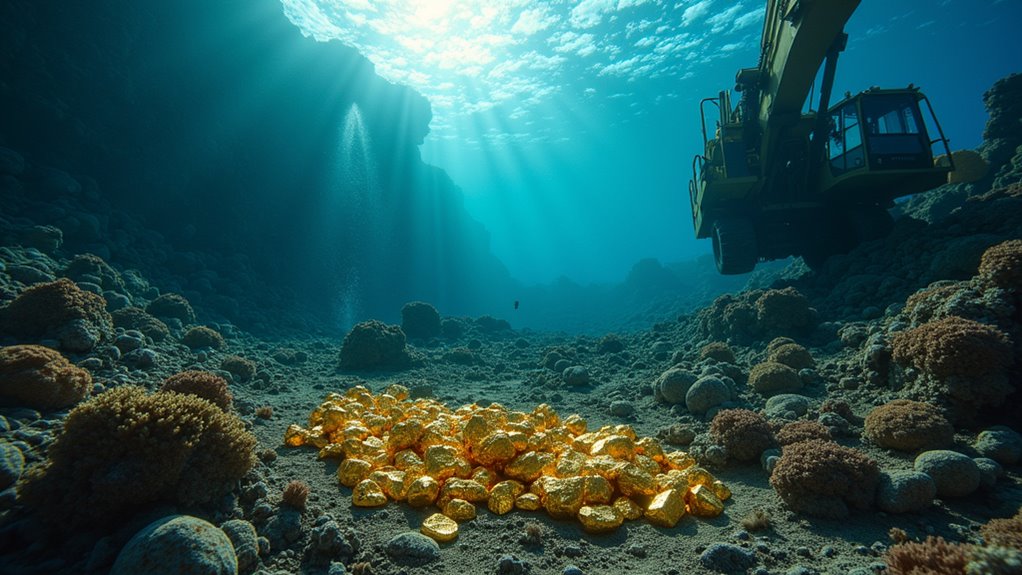Public policy shapes the future of Australian gold mining by enforcing strict regulations through state and federal frameworks, ensuring environmental care under the EPBC Act, and promoting sustainability. Economic incentives, like WA’s Exploration Incentive Scheme, boost investment despite high taxes. At Karat.au, we’re passionate about unravelling these impacts, celebrating our nation’s golden heritage with clarity. Policies balance growth and responsibility, defining the industry’s path. Stay with us to uncover deeper insights into this glittering legacy.
Regulatory Frameworks Shaping Gold Mining Operations

While the Australian gold mining industry gleams with opportunity, it operates within a complex web of regulatory frameworks that secure responsible practices across the board.
At Karat.au, we’re passionate about unpacking this intricate system, rooted in Australia’s rich mining heritage. State and territory governments primarily oversee operations, granting tenements like exploration licences and mining leases, while the federal level tackles environmental protection under the EPBC Act for nationally significant matters. Sustainable solutions such as mitigating environmental impact are crucial for the industry’s long-term viability. Furthermore, the integration of ESG principles into mining operations is becoming essential to meet both regulatory expectations and community demands. Artisanal mining practices can serve as a model for sustainable methods in larger operations.
At Karat.au, we dive into Australia’s gold mining regulations, blending state oversight with federal environmental care under the EPBC Act.
This multi-tiered approach, spanning local planning to Indigenous heritage via the Native Title Act, demands miners navigate diverse laws. Environmental Impact Assessments and mandatory rehabilitation plans promote sustainability, tho’ challenges persist. Additionally, the emphasis on sustainable practices is becoming increasingly vital as the industry faces scrutiny from both regulators and the public.
Work Health and Safety laws, tailored by states, address mining’s high risks with strict hazard controls. With a nod to our nation’s legacy, Karat.au celebrates gold’s allure while clarifying these essential regulations—making sure you’re informed, inspired, and connected to Australia’s golden heartbeat.
Economic Policies and Investment Strategies for the Industry

As the Australian gold mining industry continues to shine on the global stage, economic policies and investment strategies play a pivotal role in shaping its trajectory. High taxation, with a 30% company tax rate and varying state royalties like WA’s 2.5%, can deter investment, especially in marginal projects, despite the sector’s massive $74 billion contribution in 2022-23. However, the demand for gold stocks remains robust, as investors seek to capitalize on the potential for high returns. Furthermore, gold continues to serve as a key asset in global financial systems, reinforcing its relevance even amid modern currency fluctuations. Additionally, investment in gold has historically been considered a safe haven during economic uncertainty.
Yet, incentives such as the Junior Minerals Exploration Incentive and WA’s Exploration Incentive Scheme, offering co-funded drilling, bolster high-risk exploration.
Funding remains critical, with gold mining relying on internal cash flows, equity, and emerging sources like government agencies or offtake deals, as bank exposure drops 37% since 2015.
Rising All-In Sustaining Costs, averaging A$2,054/oz in early 2024, add pressure, driven by labour and energy costs.
At Karat.au, we reckon these policies and strategies will define the industry’s future, balancing burdens with opportunities for growth. Effective gold reserve management strategies can further enhance profitability and mitigate risks in this evolving landscape.
Frequently Asked Questions
How Do Indigenous Rights Affect Gold Mining Projects?
Indigenous rights profoundly influence gold mining projects across Australia.
Under the Native Title Act 1993, mining companies must negotiate with Traditional Owners before starting operations on claimed lands, ensuring fair dialogue.
Cultural heritage laws also demand surveys and protection plans to safeguard sacred sites.
Though sometimes challenging, these processes honour Australia’s rich heritage, fostering respect.
At Karat.au, we believe this balance preserves both history and industry, enriching our nation’s golden legacy.
What Environmental Standards Must Gold Miners Meet?
Gold miners in Australia must adhere to strict environmental standards to protect the land’s unique beauty.
They’re required to conduct detailed impact assessments, safeguard water quality, and preserve biodiversity under laws like the EPBC Act 1999.
Rehabilitation of mined areas is non-negotiable, ensuring sites are safe and sustainable.
Compliance is monitored by state and federal bodies, reflecting Australia’s deep commitment to balancing mining with environmental care.
(Source: MCA Guidelines)
How Do Cultural Heritage Laws Impact Mining Operations?
Cultural heritage laws greatly shape mining operations across Australia. These regulations, varying by state, mandate engagement with Traditional Owners and require thorough surveys to protect sacred sites.
Non-compliance can halt projects, inflate costs, or damage reputations, as seen post-Juukan Gorge. Companies must navigate complex agreements and uphold free, prior, and informed consent.
Such laws, while challenging, guarantee mining respects Australia’s rich Indigenous heritage, balancing progress with preservation.
What Social Expectations Influence Mining Policies?
Social expectations greatly shape mining policies, as communities demand transparency and fairness.
They expect companies to prioritise local employment, invest in regional infrastructure, and uphold environmental stewardship.
Respect for Indigenous rights, including protecting sacred sites, is non-negotiable.
A genuine social licence to operate hinges on trust, built through honest engagement.
At Karat.au, we believe these societal values guarantee mining reflects Australia’s heritage and commitment to sustainable, equitable growth—sorry for any typo!
How Does Public Trust Shape Mining Regulations?
Public trust profoundly shapes mining regulations, as communities demand accountability from the industry.
When trust falters, governments tighten rules, mandating transparency and consultation, like under Victoria’s Mineral Resources Act. Low trust can delay projects, pushing regulators to enforce stricter engagement plans.
With trust improving slightly (CSIRO: 3.1/5 in 2024), fairness and open dialogue remain key. Strong trust guarantees smoother operations, guiding policies to prioritise community voices over mere compliance.














